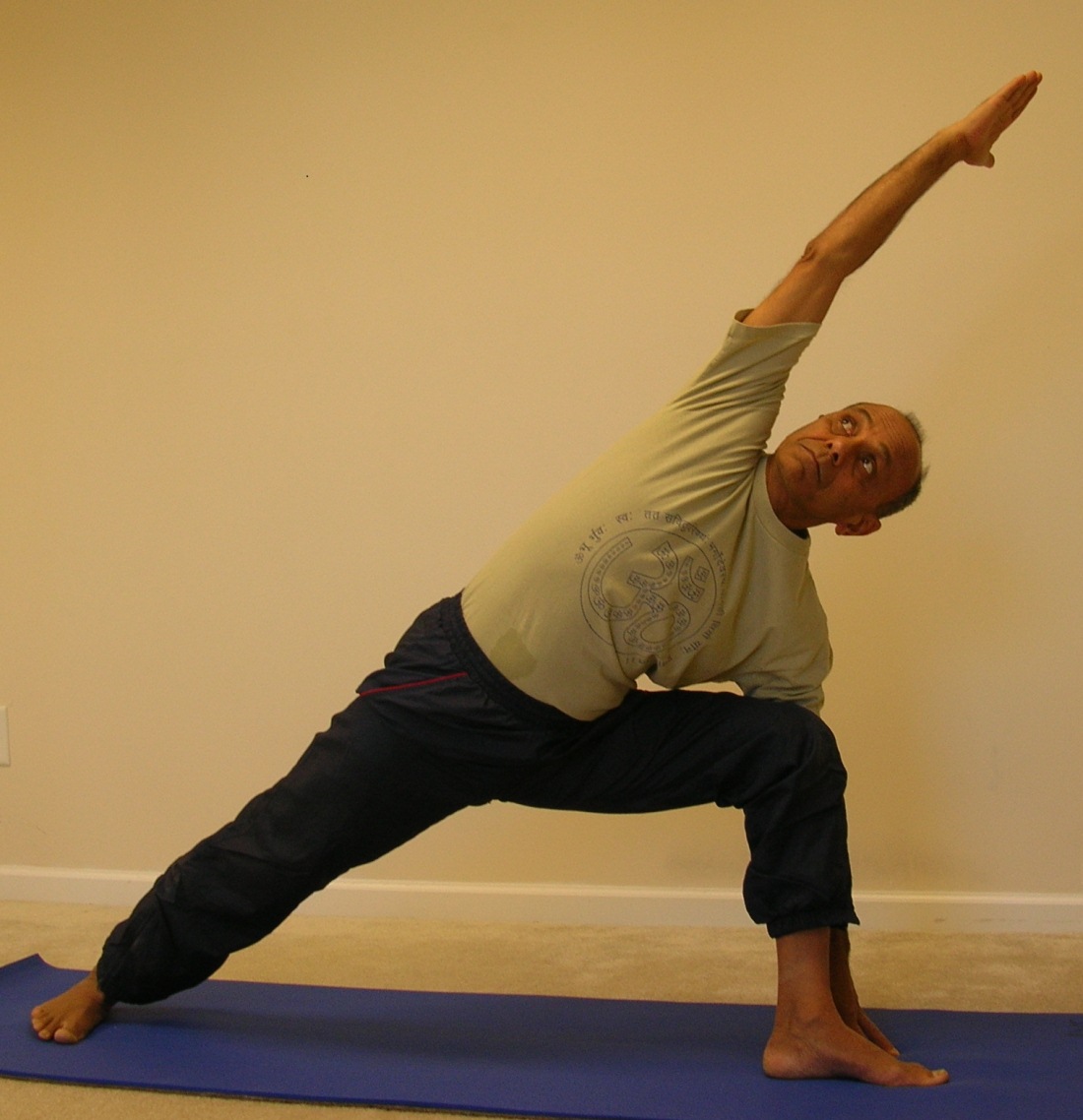Utthita Parshvakonasana – उत्थित-पार्श्वकोणासन- is an intermediate level pose and can be considered an extension of the Warrior 2 (Virabhadrasana 2) pose.
utthita = lifted and extended
Parshva = side, flank
Kona = angle
Asana = pose
It is an excellent pose for stretching and strengthening the hips, legs, ankles, knees, and the spine. In my own practice and in the classes that I teach, I usually integrate this pose as an extension of the Warrior 2 pose which itself is integrated as a part of the Surya Namaskar (Sun Salutation) routine.
Step-by-step
- Come to a standing position on your mat. Spread your feet 3.5 to 4 feet apart. Stretch your arms in line with the shoulders, parallel to the floor, palms facing down. Turn your left foot in slightly to the right and your right foot out to the right 90 degrees, the edge of the foot being parallel to the side edge of the mat. Align the right heel with the left heel. Tighten your thighs slightly and turn your right thigh outward, so that the center of the kneecap is in line with the center of the right ankle. Roll the left hip slightly forward, toward the right, and rotate your upper torso back to the left. In this posture, your body is completely parallel to the side wall of the room.
- Firmly plant the left (back) heel onto the floor. Then exhale and bend your right knee over the right ankle, so that the shin is perpendicular to the floor. If possible, with each exhalation, drop the buttocks down in an effort to bring the right thigh parallel to the floor. This is the traditional Warrior 2 pose.
- As you keep the arms stretched, try to roll the shoulders back to close the gap between the shoulder blades. Slowly stretch your left arm up toward the ceiling, then turn the left palm down and with an inhalation bring the arm over the back of your left ear, palm facing the floor. Stretch from your left heel through your left fingertips, stretching the entire left side of your body. Turn your head up to look at the left hand.
- As you continue to ground your left heel to the floor, exhale and bring the right side of your torso as close to the right thigh as possible.
- In stage one of this pose, bend the right elbow and place the elbow on the right knee. Stay in this pose for about 3-4 breaths.
- In stage 2 of the pose, make an effort to place your right fingertips (or palm) on the floor just outside of your right foot. If you are unable to reach the floor with the fingertips, you can place a block next to the foot and put your hand on the block. If you don’t have a block handy, then continue to keep the elbow on the knee.
- Actively push the right knee back against the inner arm; counter this by pushing the right thigh gently forward. The inside of your right thigh should be parallel to the long edge of your yoga mat.
- Stay in the final pose for about 5-6 breaths, if comfortable. Inhale to come out of the pose. Push both heels strongly into the floor and raise the left arm toward the ceiling. Slowly come back up to the standing pose (Tadasana).
- Reverse the position of the feet on the mat and repeat for the same length of time on the other side. Then come up and return to Tadasana
Benefits
- Strengthens the legs, especially thighs, hips, knees, and ankles.
- Stretches your groin, back, spine, waist, chest, lungs and shoulders.
- Massages and stimulates the abdominal organs.
- Increases endurance and stamina.
- Therapeutically beneficial for relieving backache, constipation and menstrual discomfort
Contraindications and Cautions
- Headache
- High or low blood pressure
- Insomnia
- If you have any neck problems don’t turn your head to look over the shoulder; instead look straight ahead with the sides of the neck lengthened evenly, or look down at the floor.
Is Utthita Parshvakonasana (Extended Side-angle Pose) part of your yoga practice? I would love to hear your experience with the pose. Please post your comments in the comment box below.

Recent Comments